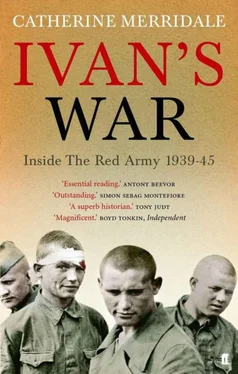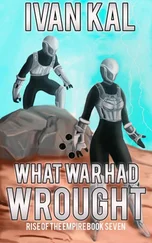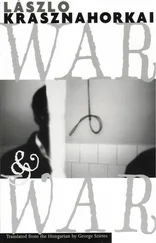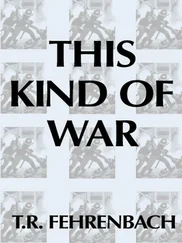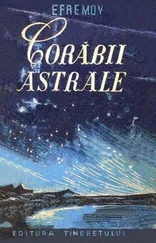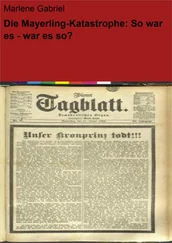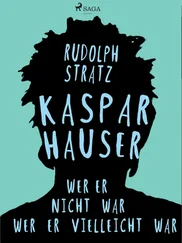48 V. V. Pokhlebkin, Velikaya voina i nesostoyavshiisya mir. 1941–1945–1994 (Moscow, 1997), p. 150.
49 Cited in Werth, p. 474.
50 Alexiyevich, p. 96.
51 Stalin and the GKO approved the recruitment of women into male combat roles in April 1942. See Velikaya Otechestvennaya , 2 (2), pp. 212–3 and 214–5.
52 RGASPI-M, 1/47/26, 175.
53 For a telling discussion of this, see Chuikov, The Beginning , pp. 221–34. The marshal describes the work of women, but always with the condescending tone of one who saw them as mere girls.
54 RGASPI-M, 1/47/49, 87.
55 Velikaya Otechestvennaya , 2 (2), 285.
56 Alexiyevich, pp. 46–7.
57 The first women snipers were trained from February 1943.
58 Alexiyevich, p. 14.
59 Reina Pennington, Wings , includes a chapter tracing Raskova’s career.
60 Gosudarstvennyi arkhiv rossiiskoi federatsii (GARF), R9550/6/62.
61 Interview, Kaluga, August 2002.
62 RGASPI-M, 33/1/563, 7.
63 Pis’ma s fronta i na front , p. 87.
64 Van Creveld, p. 73.
65 Samoilov, ‘Lyudi’, part 1, pp. 52–3.
66 GASO, 2482/1/12, 12.
67 RGASPI-M, 33/1/19, 52.
68 Ibid ., 72.
69 Ibid ., 85.
70 Ibid ., 84.
71 GASO, 2482/1/12, 7.
72 RGASPI-M, 33/1/19, 101.
73 Velikaya Otechestvennaya , 2 (2), 281.
74 RGASPI-M, 33/1/19, 36.
75 Samoilov, ‘Lyudi’, part 1, p. 56.
76 RGASPI-M, 33/1/1454, 6.
77 Po obe storony fronta: Pis’ma sovetskikh i nemetskikh soldat, 1941–1945 (Moscow, 1995), p. 43.
78 RGASPI-M, 33/1/360, 106.
79 Chuikov, The Beginning , p. 66.
80 Ibid ., pp. 78–9.
81 Werth, pp. 448–9; Beevor, Stalingrad , pp. 104–6.
82 Cited in Werth, p. 450.
83 Cited in Beevor, Stalingrad , p. 201.
84 I. K. Yakovlev et al. (Eds), Vnutrennye voiska v velikoi otechestvennoi voine, 1941–45 gg., dokumenty i materialy (Moscow, 1975), p. 16.
85 The version I heard, related by a retired general, was allegedly based on research in secret military archives. Until scholars can see the documents, the rumours will persist.
86 Krivosheev, p. 125. The total death toll for Soviet troops and airmen is estimated at 470,000 (Overy, p. 212). For the entire campaign, 17 July 1942 to 2 February 1943, the total of Soviet servicemen killed, wounded and missing, according to Krivosheev, was 1,129,619.
87 I heard this from several veterans, and a politer version appears in Temkin, p. 90.
88 Viktor Astaf’ev, ‘Snachala snaryady, potom lyudi’, in Rodina , 1991, nos. 6–7, p. 55.
89Alexiyevich, p. 59. The translator may have meant a mortar rather than a mine.
90 Interview, Kiev, May 2003.
91 RGASPI-M, 33/1/1454, 8.
92 Ibid ., 18–19.
93 Chuikov, The Beginning , p. 159.
94 For an analogy, drawn from a different war, see Philip Caputo’s brilliant account in A Rumor of War (London, 1985), p. 268.
95 John Garrard and Carol Garrard, The Bones of Berdichev: The Life and Fate of Vasily Grossman (New York, 1996), p. 159.
96 Werth, p. 467.
97 Beevor, Stalingrad , p. 195.
98 Cited in Chuikov, The Beginning , p. 253.
99 Krivosheev, p. 127.
100 Beevor, Stalingrad , p. 232.
101 Ibid ., p. 249.
102 Ibid ., p. 263.
103 TsDNISO, 8/1/25, 5.
104 Po obe storony , p. 194.
105 Ibid ., pp. 195–6.
106 See, for example, Werth, p. 554.
107 Velikaya Otechestvennaya , 2 (3), pp. 36–7.
108 Werth, p. 560.
109 Po obe storony , p. 213.
110 Werth, p. 468.
111 TsAMO, 206/298/4, 11.
112 Cited in Werth, p. 490.
113 Politruks agree on this, and so, in an assessment of morale, does the historian of Soviet warfare Amnon Sella. See The Value of Life in Soviet Warfare (London, 1992), p. 170.
114 RGVA, 32925/1/504, 29.
115 RGASPI, 17/125/214, 97.
116 See Peter Kenez, ‘Black and White,’ in Richard Stites (Ed.), Culture and Entertainment in Wartime Russia (Bloomington, 1995), p. 162.
117 Pis’ma s fronta i na front , p. 88.
118 RGASPI-M, 33/1/1454, 66.
119 Bundesarchiv-Militärarchiv, RH2-2467, p. 54.
120 Cited by Vasil Bykov in ‘Za Rodinu! Za Stalina!’.
121 RGASPI-M, 1/47/24, 26–34.
122 RGVA 32925/1/514, 48.
123 RGVA 32925/1/504, 4 and 20.
124 Ibid ., 31.
125 Tens of thousands of Gulag inmates applied to be permitted to serve at the front for the same reason. Their service would not only redeem them but reinstate their families as well. See Kozlov, Obshchestvennye soznanie, p. 11; Druzhba, p. 30; Amir Weiner, Making Sense of War: The Second World War and the Fate of the Bolshevik Revolution (Princeton, NJ, 2001), p. 148.
126 Viktor Astaf’ev’s novel Proklyaty i ubity , reissued Moscow 2002, presents this point of view in harrowing detail.
127 The first attacks in November were actually aimed at Romanians, but the point was to get at the enemy. On hatred of the Germans, see L. N. Pushkarev, ‘Pis’mennaya forma bytovaniya frontovogo fol’klora,’ Etnograficheskoe obozrenie , no. 4, 1995, pp. 27–9. Pushkarev, the ethnographer and historian, was at the front himself.
128 See Werth, pp. 411–4.
129 Simonov’s ‘Kill Him!’ is quoted in Werth, p. 417.
130 RGALI, 1828/1/25, 35.
131 Beevor, Stalingrad , p. 219.
132 Belov’s diary, ‘Frontovoi dnevnik N. F. Belova’ (hereafter Belov) is published in full in Vologda , issue 2 (Vologda, 1997), pp. 431–76; For this comment, see Belov, pp. 446–7.
133 Belov, p. 442.
134 GASO, 1/1/1500, 37–38.
135 RGVA, 32925/1/504, 94; Beevor, Stalingrad , p. 264.
136 RGASPI-M, 33/1/157, 2.
137 Sidorov, pp. 83–5.
138 RGASPI-M, 33/1/157, 3–4.
139 RGASPI-M, 33/1/1454, 73.
1 ‘Prikaz verkhovnogo glavnokomanduyushchego’, 23 February 1943, in Stalin, O Velikoi otechestvennoi voine , pp. 89–90.
2 Velikaya otechestvennaya , 2 (3), p. 97.
3 At Stalingrad itself, German losses were 91,000 prisoners of war and 147,000 dead. Meanwhile, the November–February counter-offensive at Stalingrad alone, excluding the losses sustained in August–October, cost the Red Army approximately 485,735 killed, missing or wounded. Figures from John Erickson and Ljubica Erickson, The Eastern Front in Photographs (London, 2001), p. 137.
4 TsAMO, 223 SD/1/6, 10, gives details of the non-reporting practices of rifle divisions in January–February 1943.
5 Night of Stone , p. 274.
6 For an example relating to fear among the Panfilov men, see RGASPI, 17/125/185, 23. More generally, see D. L. Babichenko, Literaturnyi Front (Moscow, 1994).
7 Ilya Nemanov, interview, Smolensk, October 2002.
8 Druzhba, pp. 33–4.
9 Samoilov, ‘Lyudi’, part 2, pp. 50–1.
10 Lev Lvovich, second interview, Moscow, July 2003. On Samoilov, see above, p. 148.
11 Samoilov, ‘Lyudi’, part 2, p. 57.
12 E. S. Senyavskaya, Chelovek v voine , p. 80; RGALI 1814/6/144, 21 (Diaries of Konstantin Simonov).
13 Stouffer, vol. 2, p. 186.
14 Rodina , 1991, nos 6–7, p. 53.
15 L. N. Pushkarev, Po dorogam voiny: Vospominaniya fol’klorista-frontovika (Moscow, 1995), pp. 34–42.
16 Sidelnikov, p. 9.
17 Translation by Lubov Yakovleva, Twentieth-Century Russian Poetry , pp. 623–4.
Читать дальше
